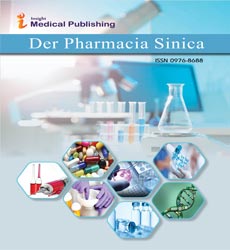ISSN : 0976 - 8688
Der Pharmacia Sinica
Overview of Drug Abuse in Children
Vijay Nigam*
Sagar Institute of Research Technology & Science - Pharmacy, Bhopal(M.P.), India
- *Corresponding Author:
- Vijay Nigam
Sagar Institute of Research Technology & Science - Pharmacy, Bhopal(M.P.), India
E-mail: vijaynigam8328@gmail.com
Received Date: May 13, 2021; Accepted Date: May 20, 2021; Published Date: May 28, 2021
Citation: Nigam V (2021) Overview of Drug Abuse in Children. Der Pharmacia Sinica, Vol.12 No.3: e001
Drug abuse is that the use of illegal drugs or the utilization of prescription or over-the-counter medications in ways aside from recommended or intended. It also includes intentional inhalation of household or industrial chemicals for his or her mind-altering effects. Tobacco use and problem drinking are sometimes included within the definition ofsubstance abuse. Chemical abuse and substance abuse are terms sometimes used interchangeably with the term drug abuse, or they'll be wont to ask a mixture of substance abuse and tobacco use or problem drinking.
In substance abuse, the drug is obtained illicitly and therefore the prescription drugs are utilized in dosages beyond that prescribed medically. Over the counter drugs used is beyond the quantity recommended on the package. Substance abuse is related to urban crime. Most heroine abuse also abuse a spread of psychoactive substances, either together or in succession.
Drug abuse may be a complicated phenomenon which is said to inter personal need, psychic and physical problems, and social adaptation. Nobody substance might be targeted as “brand switching” commonly occurred among individuals. The selection of a specific substance abuse and addiction seemed to be dictated primarily by availability. Differences within the pattern of abuse between geographic areas and among different population became apparent. White plague may be a chronic, often brain disorder that causes compulsive drug seeking and use, despite harmful consequences to the addicted individual and to those around him or her. Although the initial decision to require drugs is voluntary for many people, the brain changes that occur over time challenges an addicted person’s self-control and hamper his or her ability to resist intense impulses to require drugs.
The direct and indirect effects of alcohol and other drugs on children cause many adverse health and safety risks for the kid, family, and community. Understanding risk and protective factors which will affect the event of drug abuse may be an initiative in ameliorating the matter of drug use within the pediatric population. This text reviews the literature on the prediction, protection, and prevention of drug abuse within the pediatric population, including an inventory of obtainable prevention programs for youngsters across the age continuum.
The younger a toddler initiates alcohol and other drug use, the upper the danger for serious health consequences and adult drug abuse. Fatalities, accidental and intentional, that are related to drug and alcohol use within the adolescent population represent one among the leading preventable causes of death for the 15- to 24-year-old population. Alcohol and other drug use within the adolescent population carries a better risk for college underachievement, delinquency, teenage pregnancy, and depression. Inadvertent passive drug exposure in infants and toddlers has resulted in multiple medical complications including respiratory illnesses, seizures, altered mental status, and death.
Open Access Journals
- Aquaculture & Veterinary Science
- Chemistry & Chemical Sciences
- Clinical Sciences
- Engineering
- General Science
- Genetics & Molecular Biology
- Health Care & Nursing
- Immunology & Microbiology
- Materials Science
- Mathematics & Physics
- Medical Sciences
- Neurology & Psychiatry
- Oncology & Cancer Science
- Pharmaceutical Sciences
